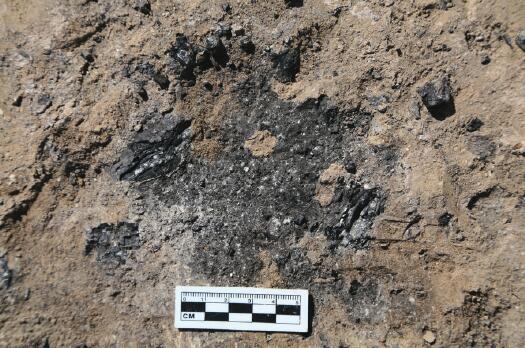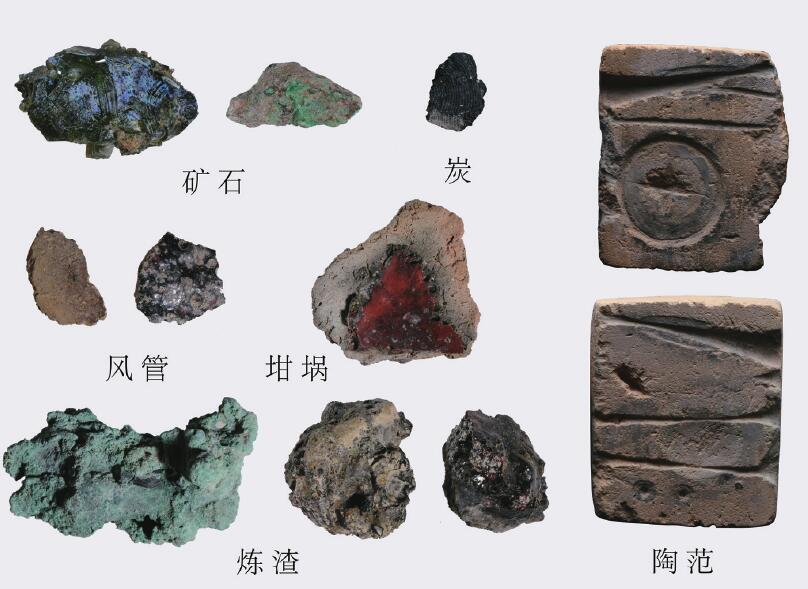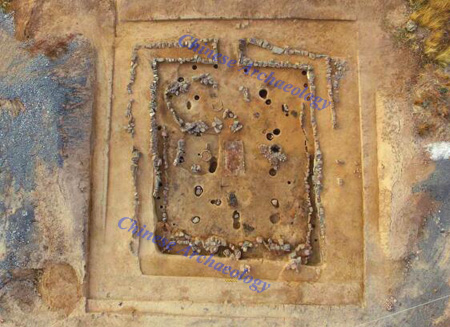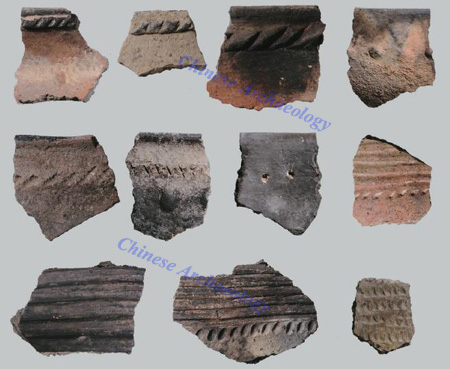The largest Bronze Age settlement and coal-usage remains in Ili region found in JirentaiGoukou Site Xinjiang
From:Chinese Archaeology NetWriter:Date:2017-01-20
JirentaiGoukou Site was located in Nilka County, in northwest China's Xinjiang Uygur Autonomous Region. It is located on the third-level terrace at the mouth of the Jirentai Valley on the north bank of Kashgar River. The site is 400 meters from east to west and 200 meters from south to north, covering an area of 80,000 square meters. From 2015 to 2016, altogether 2500 square meters had been excavated and 20 house foundations and 8 tombs were cleared. Around 1000 pieces (sets) of artifacts were unearthed, including potteries, stone, bronze, iron, and bone artifacts etc., with pottery and stone are the most.The remains found in JirentaiGoukou Site in Nilka County are mainly house foundations, and hearths, ash pits, post holes within them as well as tombs.

The findings of coal use ruins
The house foundations can be divided into two types, large ones and small ones. The large one covered an area of 100 to 400 square meters, distributed individually and of different functions and features. The plane of the house is rectangular. The structure of the house was semi-crypt made of wooden frame. The dustpan-shaped foundation was dug upon the mountain slope and the four walls were piled with rocks. Slabs were planted along the walls and wooden pillars were put up to form the wall. Two rows of wooden pillars were put up in the center of the house to support the roof. The door faced south. There was an outer wall sounding the house foundation and makes a corridor between. At the center of the house was stone hearth and the layout was balanced and rigorous. For example, house foundation F6 was located on the highest terrace in the west of the site, facing south and overlooking the below. It is the largest scale house foundation, 21meters from south to north and 17.8 meters from east to west. The whole area including the outer wall and corridor was 374 square meters and house foundation area was 240 square meters. The small house foundations ranged from 20 square meters to 60 square meters, mainly scattered in the east of the site. 8 house foundations were found in Unit T12 (740 square meters’ excavation area). They were distributed centrally and stepped on the mountain terraces. Their plans were round and rectangular, built either semi-crypt or ground architecture. Generally, there would be a round stone hearth in the center of the house. Part of the house foundations were badly preserved with only the activity surface left and unclear traces of post holes. The remains inside the house foundation were simple, mainly ash pits, hearth, activity surface, stepped surface, burning area and gravel pits. The hearth was in the center of the house and the traces of the doorway were not clear. There were few kinds of relics unearthed inside the house foundation, mainly pottery fragments, animal bones and stone tools. Judged from the stratigraphic relationship of the house, the site can be divided into two phases, the early and the later.

Copper smelting relics
A large amount of charcoals, coal ash and cinder were found inside the house foundation deposit as well as in ash pit. All these indicated people at that time had used coals as living and producing fuels.
The tombs were scattered and of small scale. The tombs were beneath the second cultural layer and three of the tombs obviously broke the cultural layers. The tombs were earthen shaft pit tombs (stone coffin). The funeral custom was unified and all of them were sideway flexed burial. There were few funeral objects, like flat bottomed pots and handled bronze mirror. The tombs were dated later than the site.
The date of the site was radiocarbon dated by Scientific Archaeological Lab in Peking University and Beta Analytic Inc. Rectified by Tree Ring dating to be 3600 years before present.

Large-scale house foundation F6
JirentaiGoukou Site was the largest and earliest Bronze Age settlement discovered in Ili region till now. It has abundant cultural connotations. Combining it with the previous found cemeteries, we deepened our understanding of specific condition of the Bronze Age Archaeological culture in Ili region. It provided important materials for the study of the social organization structure, social development stage and cultural evolution in that time and promoted the further development of archaeological study of Bronze Age settlements in Xinjiang.
Overlapped sites and the interactive broken relation cemeteries not only provided evidence for archaeological stage study of the Andronovo cultural type in Ili region, but also offers precious data for the establishment of the archaeological cultural sequence, cultural chronology and cultural structure in Ili River Basin.

Various pottery patterns
The clay moulds of bronze casting, wind pipes, slag and stove ash found in the site are the earliest in Xinjiang and even China, which clearly indicated the bronze casting production inside the site, a significant finding in Chinese archaeometallurgy study. The three iron slabs found in the site were dated to be early and of great importance to the study of iron smelting technique transmission. The remains of coal-using found in the site was the earliest in the world and it has pushed the history of coal-using forward by more than thousand years. (Translator: Yuan Yuan)

